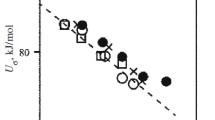To predict the process of high-rate deformation of polymer materials, the method of predicting the processes of nonlinear hereditary relaxation can be applied. Adjustment of this method is carried out by introducing a dynamic similarity coefficient. Methods based on the use of various normalized functions as relaxation ones are considered.


Similar content being viewed by others
References
N. V. Pereborova, “Criteria for qualitative assessment of relaxation-recovery properties of polymer textile materials for technical purposes,” Fibre Chem., 52, No. 3, 168-172 (2020).
M. A. Egorova, I. M. Egorov, et al., “Development of methods for improving the functional and operational properties of polymer textile materials,” Fibre Chem., 52, No. 3, 196-200 (2020).
A. V. Demidov, A. G. Makarov, and A. M. Stalevich, “Version of modelling nonlinear-hereditary viscoelasticity of polymer materials,” Izv. RAN. Mekh. Tv. Tela, No. 1, 143-153 (2009).
V. Yu. Mishakov, G. Ya. Slutsker, and A. M. Stalevich, “Mathematical simulation of deformation properties of nonwoven materials with varying stiffness,” Khim. Volokna, No. 2, 64-67 (2006).
A. G. Makarov, G. Ya. Slutsker, I. V. Gofman, and V. V. Vasil’eva, “Initial stage of stress relaxation in oriented polymers,” Fiz. Tv. Tela, 58, No. 4, 814-820 (2016).
A. G. Makarov, G. Ya. Slutsker, O. B. Terushkina, and N. V. Drobotun, “Mechanics of functioning of medical products for compression and counter-compression purposes,” Izv. VUZ. Tekhnol. Legk. Promysh., 18, No. 4, 28-31 (2012).
N. V. Pereborova, “Development of criteria for the qualitative assessment of the functional and consumer properties of textile and light industry products for the purpose of product quality management,” Dizain. Mater. Tekhnol., No. 4 (39), 98-102 (2015).
N. V. Pereborova, “Development of strategic programs for the creation of engineering centres for textile and light industry,” Izv. VUZ. Tekhnol. Legk. Promysh., 29, No. 3, 35-42 (2015).
The study was financed within the framework of the implementation of the state task of the Ministry of Science and Higher Education of the Russian Federation, Project No. FSEZ-2020-0005 and the scholarship of the President of the Russian Federation for young scientists No. SP-3895.2021.5.
Author information
Authors and Affiliations
Corresponding author
Additional information
Translated from Khimicheskie Volokna, No. 3, pp. 58-59, May-June, 2022.
Rights and permissions
Springer Nature or its licensor (e.g. a society or other partner) holds exclusive rights to this article under a publishing agreement with the author(s) or other rightsholder(s); author self-archiving of the accepted manuscript version of this article is solely governed by the terms of such publishing agreement and applicable law.
About this article
Cite this article
Kozlov, A.A. Digital Prediction of High-Rate Stretching of Polymer Textile Materials. Fibre Chem 54, 201–203 (2022). https://doi.org/10.1007/s10692-022-10376-5
Published:
Issue Date:
DOI: https://doi.org/10.1007/s10692-022-10376-5




